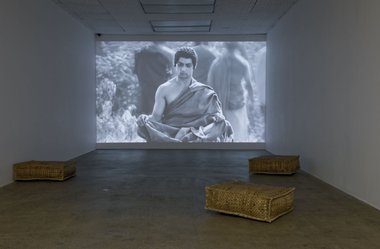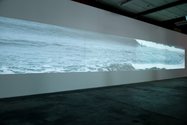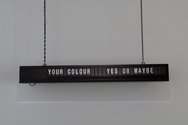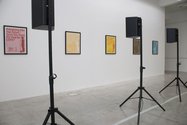John Hurrell – 29 April, 2010
Now we have the last of my five examinations of the various themes from this event: dialogue - kinds of conversation between individuals, cultures, communities, artwork and audiences that reference all sorts of values, such as notions of ‘family', sexual orientation, sporting competitiveness, even global foreign policies.
Various Venues
The Auckland Triennial
Last Ride in a Hot Air Balloon
Shigeyuki Kihara, Alex Monteith, Zheng Bo, Shilpa Gupta, Sharon Hayes, Mahmoud Bakhshi
Curated by Natasha Conland
13 March - 20 June 2010
Now we have the last of my five examinations of the various themes from this event: dialogue - kinds of conversation between individuals, cultures, communities, artwork and audiences that reference all sorts of values, such as notions of ‘family’, sexual orientation, sporting competitiveness, even global foreign policies.
Shigeyuki Kihara for the official opening of this event, presented a work that paired musical representatives of two cultures together (Maori Kapa Haka and Japanese drumming), not to make a musical hybrid or blend where difference is covered over, but rather a kind of splicing where separate cultural identities alternate. In this taking of turns there is a good natured competitiveness openly expressed between two eaily identifiable cultures and two quite different forms of musical expression. It is a little like sport, but without clear cut winners; more like a lively discussion where no clear conclusions are reached but where the pleasure is in the chat. At ARTSPACE you can see documentation of six pairings showing the spirited interaction of Chinese, Scottish, Cook Island, Brazilian, Samoan, Hindu, Aboriginal, Maori and Japanese musical/dance performance groups.
Alex Monteith’s massive screen in Shed 6, showing surfies at Stent Road wave break in Taranaki, is not the viscerally engaging work one would expect from her for the type of ‘risky’ event Conland has organised. Like Mike Parr’s project, it seems a perverse tactic by Conland to deliberately confound expectations of bodily risk. It is an anti-avantgardist gesture where the gallery goer here has no bodily empathy or engagement but instead is a remote and passive spectator watching the many rubbersuited figures calmly glide through or over the water.
The artist’s friends are seen wearing red shirts to replace the individualistic identification colours that are characteristic of competitive surfers. Of course instead of individual rivalries we now have team ones - the ‘art crowd’ versus the ‘life crowd’, for the two communities make a vivid contrast.
Zheng Bo presents an installation at ARTSPACE looking at the official Chinese view of marriage and what it entails. His film depicts life on an imaginary location called Karibu Island where time occurs backwards. The elderly suddenly arrive and gradually ‘advance’ to become babies who finally re-enter their mothers. Nearby are six panels to be examined by gallery visitors and voted on through beans being placed into bowls.
The options displayed for consideration about marriage are not clear in their demarcation. It is not just a matter of whether homosexuals should marry.(That issue is not clearly confronted. The words ‘homosexual’ or ‘heterosexual’ are nowhere to be seen) There are several other issues. These include should marriage be for life or is divorce permissible, is a partnership satisfactory without marriage’s legal sanction, and can arranged marriages work where lovers don’t choose each other? The murkiness seems to be the result of these panels being planned by a committee of heteros, gays and lesbians. The proposed lifestyle options are somewhat convoluted.
Shilpa Gupta’s black ‘cloud’ of 4000 microphones in the New Gallery refers to the Mumbai bombings of 2008 when 171 died. The mikes are clumped together with complex speaker systems hidden within, yet the sound is near inaudible because of various ‘noisier’ works nearby and the echo from the concrete floor. This bad location however accentuates an odd dialogue with her other contribution, a split-flap display board of the type often seen in airports. Such a whirling blurring noticeboard is an intriguing object in its own right. Almost like a living creature, it responds with phrases like YOURMINEOUR DEAD to the sounds of a singing girl’s voice wishing to fly high in the sky, emanating deep from within the adjacent, ominous, knobby black brain.
I found Sharon Hayes’ installation in the New Gallery too shrill and histrionic as a declamatory mode of recorded performance to take her political and personal content seriously - despite her inclusion of worthy texts from Martin Luther King’s denunciation of the Vietnam War and the private letters of lesbian writers like Radclyffe Hall. Her idea of mixing such material with her own correspondence to an ex-lover in order to harangue the US Government about their foreign policy in Iraq would probably succeed better if expressed in print, not spoken verbally. Hayes’ speech comes across as bleating and over agitated, although if shown as a text her appropriated thoughts may indicate the contrary. In the New Gallery her ‘speeches’ are played through five speakers on stands, but here you can see her for yourself on youtube. What do you think? Perhaps I am too easily irritated? I think the work needs distance. It is too personal.
Mahmoud Bakhshi’s work in Shed 6 was only functioning properly for a very short time. Apparently it features adjustable speakers playing recordings of different calls to prayer in Tehran at sunset, each one based on a different chapter of the Qur’an. Visitors were meant to modify the sound by turning the vertical columns around, constantly changing the overall aural mix. It sounds like a fascinating comment on interpretative communities, so for this Triennial its breakdown is highly unfortunate, if not calamitous. Shed 6 badly needs more obvious energy, otherwise it remains a gloomy black hole.
In summing up, this year’s Triennial is not an overwhelming success, though it is definitely more exciting than Turbulence. However the first two, organised by Allan Smith for 2001, and Ngahiraka Mason and Ewen McDonald for 2004, though with less overseas art stars, seem in hindsight to have been more consistent with more sparkle. Maybe AAG got caught out by Natasha Conland’s pregnancy, although the abysmal failure of Shed 6 is balanced by the success of St. Paul St and George Fraser, and some exciting surprises in the New Gallery. ARTSPACE is also worth exploring. Be sure to do that before it closes at the end of this week.
John Hurrell
Recent Comments
Kate Brettkelly-Chalmers
Hmmmmm, maybe you are not familiar with the swirl of discourse surrounding motherhood and careers? When you put the term ...
Editor
Kate, what I said was not remotely sexist. Where did I say something derogatory about Natasha Conland because she is ...
Kate Brettkelly-Chalmers
John, you know I like to avoid this whole blog commenting thing, but really, the pregnancy remark is unforgivable. I’ve ...








 Advertising in this column
Advertising in this column Two Rooms presents a program of residencies and projects
Two Rooms presents a program of residencies and projects



This Discussion has 10 comments.
Comment
Lydia Chai, 3:07 p.m. 29 April, 2010 #
Totally agree with the Sharon Hayes work. It was almost unlistenable!
Pauline Dawson, 3:56 p.m. 29 April, 2010 #
"Maybe AAG got caught out by Natasha Conland’s pregnancy" How is a curator's pregnancy even the slightest bit relevant in this context????
Editor, 4:22 p.m. 29 April, 2010 #
It is extremely relevant Pauline. Events like Triennials invariably get driven by a highly motivated individual, the person who created the underpinning concept. By stating this obvious fact I am not (by the way) denying the value of the considerable teamwork of Natasha's colleagues within AAG or the hard work somebody like Hanna Scott (NC's stand-in) has put in.
I seriously believe that if Natasha had not been pregnant the Triennial would have been fine tuned a lot better, and some of the disasters - like the layout of the works in the Shed - would not have occurred. In coming up to the finishing post, some of the final details went awry.
Pauline Dawson, 4:25 p.m. 29 April, 2010 #
So you are saying it was her absence / unavailability rather than "the pregnancy" that was the issue?
Editor, 4:36 p.m. 29 April, 2010 #
Why would I think otherwise? One is the result of the other. No big deal. Do you think I have some kind of pathological hatred of motherhood or something, Pauline?
What is so unspeakable about pregnancy?
Pauline Dawson, 4:39 p.m. 29 April, 2010 #
Well, I just wondered if it was a male curator absent for some reason, that the reason would be mentioned.
Editor, 5:10 p.m. 29 April, 2010 #
If it were common knowledge at the Triennial events, and even mentioned in the opening speeches, then it would.
From your point of view, as a non-Aucklander, perhaps you are correct to point out my writing lacked concision.Pregnancy was not the point of what I was getting at.
Kate Brettkelly-Chalmers, 1:17 p.m. 18 May, 2010 #
John,
you know I like to avoid this whole blog commenting thing, but really, the pregnancy remark is unforgivable. I’ve just read this review and the comments and I’m not sure you’ve got Pauline’s point. What you’ve written is SEXIST. It goes directly to the heart of contemporary feminist concerns: how horribly hard it is to have a good career and life outside of that. Quite frankly, men don’t seem to have this problem. I’ve read your reviews of the ARTSPACE shows of September 2008 when a certain curator/director became a father. Fortunately, there is no mention of parenthood here. There isn’t because it is totally unnecessary. You saw no reason to draw any connection between the show and the curator’s personal life. What made you draw these connections with regards to the Triennial is an underlying, pervasive and unquestionable sexism. Whether you consciously intended this or not, it just goes to show that all is not equal in art and life.
Phew. I feel better for having said this.
Editor, 2:30 p.m. 18 May, 2010 #
Kate, what I said was not remotely sexist. Where did I say something derogatory about Natasha Conland because she is a woman and a mother?
My comment was about her absence as the driving force behind the show, and AAG's not successfully coping with that - though a valiant attempt was made. Her maternal condition was referred to in the opening speeches so it was common knowledge in Auckland. It was in the public domain, and not personal or private info.
What I did botch was my contextual account of the scenario for readers living south of the Bombay Hills.I was not clear and deserve criticism for that.
Kate Brettkelly-Chalmers, 12:36 p.m. 19 May, 2010 #
Hmmmmm, maybe you are not familiar with the swirl of discourse surrounding motherhood and careers? When you put the term "pregnancy" so close to the phrase "abysmal failure" steam blows out the ears of feminists all around the world....
Maybe have a look at this issue of the NZ Listener (http://www.listener.co.nz/issue/3646/15145.html) that explains that mummies were much happier in the 50s wearing pearls and an apron than they are in this century holding a cell phone and wearing a matrix of frown lines. Thank god for Gemma Gracewood who points out how crap this is (in much more eloquent terms) in this episode of Media7: http://tvnz.co.nz/media7/s4-e7-video-3444378
Or maybe you could just put it down to biological determinism. Maybe feminists have evolved to be irrationally pissed off at everything. Maybe I have a genetic predisposition to read into things too much. After all, according to this guest on Kim Hill (http://podcast.radionz.co.nz/sat/sat-20091212-0845-Daniel_Kruger_sex_and_shopping-048.mp3) women have evolved to like shopping. Especially in foreign countries!
Seriously now, I have quite an archive of contemporary examples of sexism at my fingertips. I "collect" them because I am acutely aware of their impact. I watch out for them. I suggest that you, John, don't have this kind of awareness. We come from different sides of the track. Let's leave it at that.
Participate
Register to Participate.
Sign in
Sign in to an existing account.